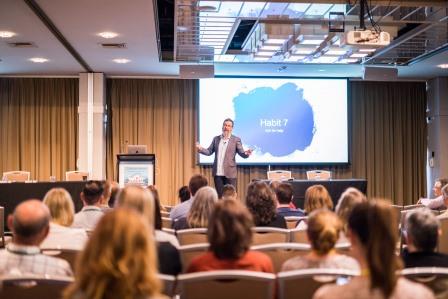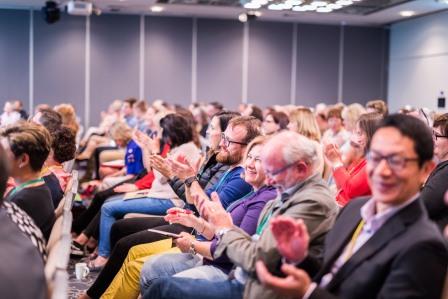JANE PORTNOY
Jane Portnoy, Social Worker – Haemophilia
The Alfred hospital, Melbourne
Youth – what’s the risk?
Chair: Dr Moana Harlen
Risk taking was the topic: the audience were asked to decide if a particular action was high, medium or low risk, and then three groups, a group of health professionals, a group comprising a young woman and a young man with bleeding disorders and a third group of a parent and an adult with a bleeding disorder, were asked to decide if a certain decision was high risk, medium risk or low risk. This was an interesting session with lively discussion and strong audience participation.
While there was agreement for many of the activities, there were lots of differences in the way that we assessed risk between the groups. Interestingly there was a less conservative perspective in the voting from the professionals, who felt that many of the risk levels were lower than the audience and the other groups. Some considered the question in the context of the person’s general health, and even factoring in their hopes and dreams, their mental health, and acknowledging the cost of ‘missing out’. Of course, for many people with bleeding disorders ‘missing out’ is very familiar, with the associated frustration, and sometimes compounding to lead to rejection of treatment, long term dissatisfaction and heartbreak.
Even if the ultimate decision is to not take a risk, acknowledgement of these other costs makes the decision more acceptable and easier to live with.
Self-advocacy
Chair: Loretta Riley

Loretta Riley developed the concept and led the Self advocacy workshop. It was presented in a fun way that successfully inspired participation, using the notion of a ‘café’. Four tables were presented with different menus. These were colourful café style sheets, with First course, Main Course and Dessert as well as Drinks options. It stimulated curiosity and interest as patrons/participants sat down. We all wanted to be in this Café.
Participants were asked:
Please describe a moment when self-advocacy worked well for you.
What resources/skills do you use to advocate successfully for yourself?
What makes self-advocacy difficult and what ways could these be overcome?
There was interesting analysis and sharing of experience. Through this the groups came up with extensive collections of ideas to share. I have included some of these here.
What are the skills or resources that you use to advocate successfully for yourself?
The Self advocacy workshop allowed for a sharing of information: although everyone has certain skills, there was much to learn from others. The strategies, approach and techniques used were diverse and successful in different circumstances. The ability to use a variety of different approaches also allows for more success.
The strategies employed when there were barriers allowed for diverse and creative approaches. There was animated discussion and a level of energy that is often needed in these situations.
There were some Ah-Ha moments when members of the group realized that someone else’s strategy could be used in their own situations. Preparation and support were two ways that people overcame barriers.
Here are some of the possible solutions/strategies to use when there are barriers:
Self-advocacy is a really important skill, particularly if you have a chronic illness. There are skills which you can build, and it really helps if you get support to do this.
MOANA HARLEN
Dr Moana Harlen, Senior Haemophilia Psychologist
The Queensland Children’s Hospital
Dr Happy (Dr Tim Sharpe) – Challenging the status quo

Dr Tim Sharp (aka Dr Happy) introduced himself as the Chief Happiness Officer (CHO) of The Happiness Institute. This cheerful yet humble title reflects Dr Sharp’s passion for promoting positive psychology, which he explained is the academic study that helps people to do more than survive, but to thrive and flourish and to live a meaningful and purposeful life even in times of adversity.
His presentation described 9 Habits for Happiness.
Habit 1. Create your own definition of what happiness really means to you.
Dr Happy discussed the importance of adjusting your versions of happiness over time. When the audience was asked ‘how many people would like to be happier?’ unsurprisingly there was a majority show of hands. However, this changed when the question was posed ‘how many of you have a happiness plan?’. I wonder whether my plans to go camping and boating could be considered a happiness plan?
Habit 2. Set and work towards meaningful goals
Dr Happy reiterated that the stepping stones to a great life consist of developing SMART goals. I think we are all familiar with these but as a reminder, here they are:
Habit 3: Laugh, play and have fun
Dr Happy discussed research that has shown when fun and play are used in constructive and appropriate ways, it can lead to positive outcomes such as increasing the likelihood of working through problems.
To demonstrate that positivity can increase desirable behaviours, he presented a video on ‘fun therapy’. It gave an example where simply adding some novelty feedback in the form of fun flashing lights and messages to a drink disposal container increased the number of times people disposed bottles into the container to more than 100 compared to a rather boring ordinary bottle disposal bin which was only used twice.
I liken this to how children can develop a love of reading simply by experiencing warm positive feelings when a parent reads to them at bedtime.
Habit 4: Jump out of an airplane
Dr Happy shared his own personal feeling of joy when he once did a tandem skydive. He later reflected on this incredible experience as helping him to create a positive reaffirming belief about himself, that is, ‘If I can do that, what else can I do?’. He further explained that to live our best life we need to confront adversity, because if we never take any risks we never learn.
I like to think of this as stepping (or being pushed) outside of our comfort (what is familiar to us) zone into our uncomfortable (stress) zone or we could view it more positively as our learning zone, which eventually becomes part of our comfort zone.
Extending on this, Dr Happy commented that it’s not possible for parents to protect their children from everything; children will more likely develop resiliency skills if they experience boredom and frustration at times.
I can tick this box and say I have also jumped out of a perfectly good plane and found it the most exhilarating experience of my life. What did I learn, you ask? On reflection, I realised that a far scarier thing for me to do would be to go into a small underground cave and confront my claustrophobia but then again, sometimes it’s also good to play to your strengths, I say.
Habit 5: Exercise your right to be happy
I love Dr Happy’s play on words here. He goes on to say that the simplest mood enhancer is exercise; it is a stress buster and enhances positive emotions. Bodies are made to move; find some way of moving that you enjoy.
On the other side of the coin to exercise is a healthy diet, which Dr Happy succinctly phrased as eating more real food and less processed foods.
Habit 6: Sleep your way to the top
Good quality and adequate sleep is important. It’s hard to be happy if you’re tired all the time.
Habit 7: Ask for help

Dr Happy suggested that women are better at asking for help. However, he pointed out, if we want to be the best we can be, we can’t do it on our own.
The stigma of mental health disorders such as depression is a barrier to men asking for help. It is of great concern that suicide is the leading cause of death for men under 45 years.
How can we best help each other? Dr Happy described a study that analysed interactions between patients with chronic pain and their spouses. Being a carer is one of the most difficult tasks there is, and carers have higher rates of depression. The study asked, ‘What was the impact of how carers responded to their partners?’ More specifically it looked at ‘how my wife responds to me about how dysfunctional I am.’
Three broad categories of responses were found:
1. Angry responses were found to not be helpful to the person with chronic pain.
2. Overly solicitous responses, that is, doing everything for the person with chronic pain, made him become more dysfunctional.
3. Supportive responses, were those such as, let me help you to help yourself.
Findings showed the best interactions were where people help one another to become the best people we can become.
An important contributor to longevity is the quality of relationships: ‘other people matter’.
Habit 8: Give help
Research into volunteering shows that giving help and doing good for others increases our feeling of wellbeing and improves our health and happiness.
Habit 9: Choose your focus
Dr Happy recommended that we take care about what we focus on – that we be cautious of focusing on what’s wrong with the world versus what’s right. He asked us to consider the news, for example: how much of it is bad news? Perhaps it is time to stop watching the news and actively seek out good news regularly – and focus on what is relevant or important. To prove his point, Dr Happy provided video footage showing the many acts of love, kindness and courage which exist aplenty in our world.
This was a powerful reminder of how easy it is to get a warped picture of what happens in the world by only focusing on the negative; but by choosing to focus on the positive qualities of humanity, it can help us to gain a more balanced and realistic view of the world.
Another important aspect of this raised by Dr Happy was the impact of comparing ourselves to what we see on social media posts: where people only post their best face and the smiling and beautiful moments of their lives and we don’t see what didn’t go right, or the lumps and bumps of the rest of their life. He explained that comparing our messy imperfect lives with this curated reality will only cause feelings of inadequacy and it is important to recognise social media for what it is.
Practicing gratitude has become very popular, but what does the research say about its benefits? Interestingly, studies have confirmed that people who practice gratitude are happier people. One technique is to ask, ‘what’s the three best things that happened today?’
A key to self-development and self-improvement is knowing your own character strengths. Dr Happy provided this website where you can complete a free survey to find out your particular strengths – www.viacharacter.org. Give it a go.
There are other free tools and fact sheets on his website and he invited us to have a look if we want more information – www.drhappy.com.au
Habit 10: There’s always more happiness than you think
This extra habit was a gift that Dr Happy gave to us in parting.

I left this presentation feeling inspired to make a happiness plan and to look at a meaningful way to apply the 10 habits.
Haemophilia Foundation Australia acknowledges the Traditional Owners and Custodians of Country throughout Australia, the land, waters and community where we walk, live, meet and work. We pay our respects to Elders past and present and extend that respect to all Aboriginal and Torres Strait Islander peoples.
Sign up for the latest news, events and our free National Haemophilia magazine